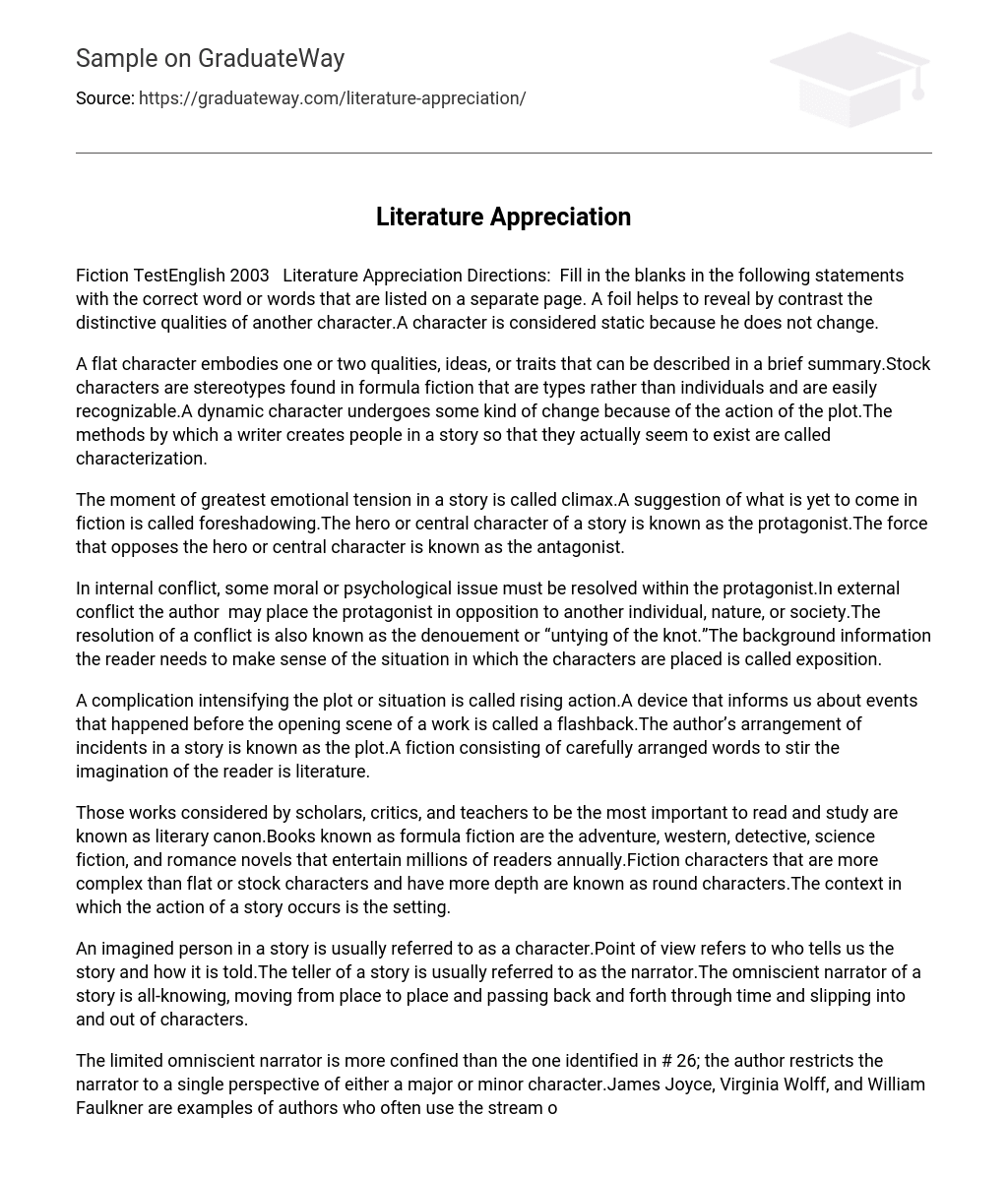Fiction TestEnglish 2003 Literature Appreciation Directions: Fill in the blanks in the following statements with the correct word or words that are listed on a separate page. A foil helps to reveal by contrast the distinctive qualities of another character.A character is considered static because he does not change.
A flat character embodies one or two qualities, ideas, or traits that can be described in a brief summary.Stock characters are stereotypes found in formula fiction that are types rather than individuals and are easily recognizable.A dynamic character undergoes some kind of change because of the action of the plot.The methods by which a writer creates people in a story so that they actually seem to exist are called characterization.
The moment of greatest emotional tension in a story is called climax.A suggestion of what is yet to come in fiction is called foreshadowing.The hero or central character of a story is known as the protagonist.The force that opposes the hero or central character is known as the antagonist.
In internal conflict, some moral or psychological issue must be resolved within the protagonist.In external conflict the author may place the protagonist in opposition to another individual, nature, or society.The resolution of a conflict is also known as the denouement or “untying of the knot.”The background information the reader needs to make sense of the situation in which the characters are placed is called exposition.
A complication intensifying the plot or situation is called rising action.A device that informs us about events that happened before the opening scene of a work is called a flashback.The author’s arrangement of incidents in a story is known as the plot.A fiction consisting of carefully arranged words to stir the imagination of the reader is literature.
Those works considered by scholars, critics, and teachers to be the most important to read and study are known as literary canon.Books known as formula fiction are the adventure, western, detective, science fiction, and romance novels that entertain millions of readers annually.Fiction characters that are more complex than flat or stock characters and have more depth are known as round characters.The context in which the action of a story occurs is the setting.
An imagined person in a story is usually referred to as a character.Point of view refers to who tells us the story and how it is told.The teller of a story is usually referred to as the narrator.The omniscient narrator of a story is all-knowing, moving from place to place and passing back and forth through time and slipping into and out of characters.
The limited omniscient narrator is more confined than the one identified in # 26; the author restricts the narrator to a single perspective of either a major or minor character.James Joyce, Virginia Wolff, and William Faulkner are examples of authors who often use the stream of consciousness technique to take a reader inside the character’s mind to reveal perceptions, thoughts, and feelings on a conscious or unconscious level.29. With a first – person narrator, the I presents the point of viewof only one character’s consciousness.
30. A symbol is a person , object, or event that suggests more than itsliteral meaning.31. When a character, object, or incident indicates a single, fixed meaning, the writeris using allegory.
32. A literary symbol can include traditional, conventional, or publicmeanings, but it may also be established by the context of the work in which it appears. 33. The central idea or meaning of a story is the theme.
34. Style refers to the distinctive manner in which a writer arranges words to achieve particular effects. 35. Diction refers to a writer’s choice of words.
36. The author’s implicit attitude toward the people, places, and events in a story is called tone. 37. A device that reveals a reality different from what appears to be true is known as irony.
38. Situational irony exists when there is an incongruity between what is expected to happen and what actually happens. 39. Verbal irony consists of a person saying one thing but meaning the opposite.
40. Dramatic irony creates a discrepancy between what a character believes or says and what a reader understands to be true. 41. Cultural critics, like literary historians, place literary works in the context of their times, but they do not restrict themselves to major historical moments or figures.
Answer these questions in complete statements: Which story that we read is most representative of the use of plot? Why do you think so?Which story that we read is most representative of the use of setting? Explain your choice.3. Which story that we read is most representative of the use of character? Explain your choice. Terms to use for the test cultural critics theme dramatic irony style verbal irony diction situational irony irony tone round formula fiction foil literary canon literature flat stock characters plot dynamic characterization flashback rising action static climax exposition foreshadowing resolution protagonist external ( conflict) internal ( conflict) antagonist literary symbol setting allegory symbol character first-person point of view narrator stream-of-consciousness limited omniscient narrator omniscient narrator





